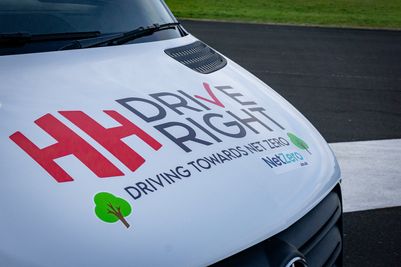Maintenance Compliance Slipping as Fleets Underplay Legal Duties
Published:
Read Time: 6 mins
Fleet operators are increasingly regarding roadworthiness as a recommendation rather than a legal requirement, says fleet vehicle security and compliance technology expert, HH Driveright.
The Garforth-headquartered award-winning business says the pressures of hiked operational costs and higher insurance premiums are leading to fleet operators turning a blind eye to maintenance requirements and deviating away from the schedule declared in their VOL (Vehicle Operator’s License).
The technology solutions provider has noted, through its own data and involvement with the sector, that defects and maintenance issues are not being addressed to the timescales that compliance demands. Cost saving would appear to be the underlying reason for this.
HH Driveright warns those within fleet operations, who are taking the decision to hold back on maintenance, are at risk of severe penalties, should a vehicle defect lead to an accident in which either driver or member of the public is injured or killed.
At an employer level, possible penalties include prosecution for corporate manslaughter, whilst an individual could be prosecuted for gross negligence manslaughter.
However, the legal responsibility for ensuring vehicle roadworthiness ultimately rests with the driver. If they fail to insist on their employer repairing a defect, or if they pay no attention to their legal responsibility of carrying out a daily walkaround check, they could also literally find themselves in the dock facing fines, prosecution and a potential prison sentence.
“The issue we are seeing is two-fold, with shared failure to act on roadworthiness from both fleet managers and their drivers,” says HH Driveright’s managing director, Rebecca Hall.
“Employers are overlooking their legal duty to ensure the health and safety of employees – and others who may be affected by their activities – wherever employees are operating and wherever those activities take place. This could be on a myriad of highways and streets around Britain, where a vehicle, which has not been correctly maintained, could cause harm.
“Drivers are meanwhile frequently ignoring their legal responsibility to flag up vehicle defects. Anything from a minor to catastrophic incident could occur if a brake or steering issue, tyre problem, or lack of obstacle warning facility, be that a mirror or broken reversing alarm, is left unaddressed. The daily walkaround check simply has to be conducted and recorded, or the driver is breaking the law. At the same time, the employer could be deemed complicit, for failure to request signed checklists and for negligence in monitoring the situation.”
It is a legal requirement for fleet operators to carry out risk assessments that include risks on the road. Vehicles used in the workplace should be suitable for the purpose for which they are used. If a vehicle is not correctly maintained, it is not meeting that requirement.
The Health and Safety Executive (HSE) makes it clear that planned inspections are a vital part of preventative maintenance, with this including daily walkaround checks and regular maintenance inspections based on either a set maintenance interval timeframe or mileage.
It says drivers should be given a list of daily checks to carry out and should sign a document, then held on file, that confirms they checked all items listed. Their employer should be rigorously monitoring this, to ensure the driver is carrying out their legal daily duty, and then keeping the evidence on file.
The walkaround check should be carried out at least once every 24 hours and by any driver required to drive that vehicle. This goes back to the responsibility lying with the individual driver in charge of the vehicle. No driver should rely on a colleague’s check.
To ensure drivers perform this duty correctly, the employer should provide training and also overcome any language barriers by providing information in a driver’s mother tongue. It is imperative the driver fully understands their legal responsibility for the condition of their vehicle and that they flag up any defects or symptoms of defects, on an ongoing basis.
However, from that point, where a driver reports a defect, the fleet operator/employer needs to act. They should either repair the defect or, if necessary, take the decision to take the vehicle off the road, until the defect is repaired. Each fleet needs a responsible person who will take a defective vehicle out of service, until fit for purpose again.
Driver defect reports should also be kept for at least 15 months but such evidence is often paper-thin within some fleet offices. HH Driveright says that drivers should be insisting on assurances that their compliance in reporting issues is being recorded and that failure to support a driver in this way is a major breach of trust.
It is not just the daily walkaround being ignored. HH Driveright says periods between formal safety inspections are also increasing and regular service intervals are being extended. First-use inspections are rare, despite fleets sometimes not checking that there has been a safety assessment by the vehicle supplier or rental company.
Whenever the scheduled safety inspections are carried out, all details must be recorded in full, so the paper trail is in place. Using an electronic system, like HH Driveright’s App, can assist with this and also prompt the end user to record all relevant details of the vehicle, the date of the inspection, the name of who inspected the vehicle, any defects recorded and the repair work that then took place, along with the dates of such work.
Again, such evidence should be retained for 15 months or longer and can be a vital form of defence, should a legal prosecution or liability case emerge, alongside an allegation of poor maintenance being the underlying cause of an incident.
Recording and keeping ‘nil defect’ reports can demonstrate that the maintenance and roadworthiness regime was robust and that defect surveillance was in operation. These records should be kept for at least three months.
Rebecca Hall says: “Our aim, as a technology provider, is to help fleets create an end-to-end trail of evidence that demonstrates legal compliance, in as easy a way as possible. Having the prompts at hand, along with in-built information relating to the dates on which safety inspections are required, for each vehicle, is one way to ensure the maintenance regime does not slip. All data relating to maintenance can be accessed on a dashboard, at any time.
“However, we are specialists in the bespoke and can go further for a fleet, helping them to create a system built around their unique operation. For instance, we could red flag a vehicle that might need quicker inspection, whether that is because it is suddenly working on longer routes and adding more mileage, or because dashboard data shows a vehicle being driven in a way that is harsh on the brakes or steering. We can basically build whatever system a particular business needs, to stay compliant and collate all evidence of compliance. We do not just provide ‘off the shelf’ solutions but ones that can become the cornerstone of compliance within the framework of a business’s individual operations.”
Regulatory and legal action against employers and individuals who make poor decisions that lead to incidents and tragedies are ever more common. The legal definition of roadworthiness is compliance with the vehicle construction, road safety, environmental and operating standards required by UK law. It is not a choice but a necessity, if an operator and driver wish to avoid fines, licence revocation and a possible prison sentence and criminal record.
For help with a system that will help control legal maintenance requirements in your business, call HH Driveright (www.hhdriveright.com) on 01937 830144.
Ends
Editors notes
HH Driveright is an award-winning vehicle security and compliance specialist, with exciting and advanced solutions for van drivers, caravan owners and car drivers wishing to protect their vehicles, livelihood and reputation. It won the 'Keeping Your Show on the Road' award at the 2022 Logistics UK Van Awards and is continually finding ways to achieve that goal, to keep vehicles and their drivers or owners safe and protected.





